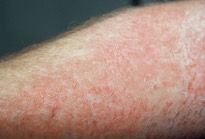CONTACT DERMATITIS
Allergic contact dermatitis is caused by your body’s reaction to something that directly contacts the skin. Many different substances can cause allergic contact dermatitis, which are called ‘allergens’. Usually these substances do not cause trouble for most people, and may not even be noticed the first time the person is exposed. Once the skin becomes sensitive or allergic to the substance, it will produce a rash within hours or as late as a week.
 Allergic contact dermatitis is not usually caused by things like acid, alkali, solvent, strong soap or detergent. These harsh compounds, which can produce a reaction on anyone’s skin, are known as ‘irritants’. Although some chemicals are both irritants and allergens, allergic contact dermatitis results from brief contact with substances that don’t usually provoke a reaction in most people.
Allergic contact dermatitis is not usually caused by things like acid, alkali, solvent, strong soap or detergent. These harsh compounds, which can produce a reaction on anyone’s skin, are known as ‘irritants’. Although some chemicals are both irritants and allergens, allergic contact dermatitis results from brief contact with substances that don’t usually provoke a reaction in most people.
The dermatitis usually shows redness, swelling and water blisters, from tiny to large. The blisters may break, forming crusts and scales. Untreated, the skin may darken and become leathery and cracked. Allergic contact dermatitis can be difficult to distinguish from other rashes, especially after it been present for a while.
Allergic contact dermatitis is responsible for approximately half of all contact dermatitis cases. Patients with persistent, unresolved contact dermatitis can suffer for years with a diminished quality of life and increased medical treatment costs. However, the condition can be effectively treated once an accurate diagnosis is obtained.
Contact Dermatitis Treatment
Dr. Green routinely performs patch tests to help patients diagnose the cause of their contact dermatitis. Patch testing is a safe and quick way to diagnose contact allergies. A small amount of the suspected allergen is applied to the skin for a fixed time, usually two days. Items like nickel, rubber, dyes, and poison ivy, poison oak and related plants are fairly common allergens that are determined to be the cause of the rash. Once the cause is determined, the patient is provided with material informing them of how to avoid the allergen in commonly used products, so the patient will not repeatedly get this rash.


